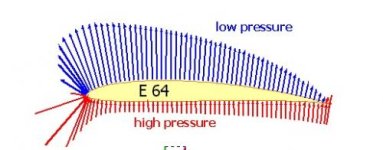Actually the airFLOW is the cause-the partial vacuum is part of the effect as well.
Thrust is the cause of the air flow "speed is life".
Airflow is the cause of the lower pressure area.
The lowered pressure area is the cause of lift.
I think I covered quite a bit of this in the Muzzle Brake thread a while back. It has a lot to do with the redirection vs impact and gaining up to 2x of the winds momentum and transferring it to the schooner rig.
http://www.benchrest.com/forums/showthread.php?t=58233
I didn't jump in until post #65 - but the principles were touched upon earlier
Most airfoils are not flat on the bottom, but also concave in the same manner that the top is convex - again like the schooner sail.
Some are, notably ultra lights and parasails plus a few of the earliest wood and wire aircraft, but its not necessary for the lower surface to be curved for lift, curved lower surface can improve low speed performance. In its most radical form it can result in ground effect but thats outside the basic principle of lift.
If the curved under surface were efficient then the Taube would have out performed the Eindecker.
I've never seen a fighter or racing aircraft with noticable curvature of the lower surfaces.
A deeply curved wing increases drag as well as lift, landing flaps work on this principle for temporary increase in lift.
B24 bombers used to use the flaps to bump the heavily loaded craft upwards but at the cost of scrubbed off inertia. They used this only in emergencies and the flaps were deployed for only seconds, the scrubbing off of inertia caused airspeed to drop rapidly.
I think you are getting into the "longer path" controversy whitch is not my point at all.
When the low pressure side is disrupted from laminar flow into turbulent cavitation the "vacuum" forming low drag laminar airflow turns into the vacuum forming high drag of cavitation and vortices - destroying the lift to drag ratio needed for continued forward motion.
There is still an area of low pressure above the wing, just more drag - because of the pressure differential in the direction of motion vs perpendicular to it against gravity.
It does but that does not change the fact that air impact to the lower surface does not produce any decernable lift, even through the impact is much greater than in a low angle of attack.
As you say the low pressure area becomes drag, evidence that lack of matter and lack of energy can offset the effects of matter and energy just as the same low pressure area is the causation of lift, the key element of the order of cause and effect that begins with thrust.
The main confusion still comes from the venue factor.
When studying simulations of airflow or wind tunnel images, the POV of the observer tends to suggest that the air moves while the craft stands still, like a sailboat whos sail has just been unfurled and must wait on the wind , driven by the sun's energy to begin the process, rather than the opposite.
The airfloil impacts the air, not the other way around, unless you try to increase lift thru the Coanda effect.
The air pressure of the atmosphere remains the same everywhere around the aircraft other than in the low pressure zone above the wing. The increased impact of the aircarft to still air does not change the qualities of earth's atmosphere regardless of localized effects.
An analogy would be atmospheric skip, the re entering space craft is re directed not by stored energy of the air it impacts, but as a product of the molecules of air resistence to movement, the spacecraft impacts the air not the otherway around, and this is much more clearly understood since it is returning from an airless environment. Lift is irrevelvant in that case since skip rebounds the aircraft back out of the atmosphere, to either orbit again or be hurtled back into space forever, like a bullet or tossed stone glancing off a pond.
PS
Vibe the problem your company had may be related to the Coanda effect.
No way to know without examing the entire system.


